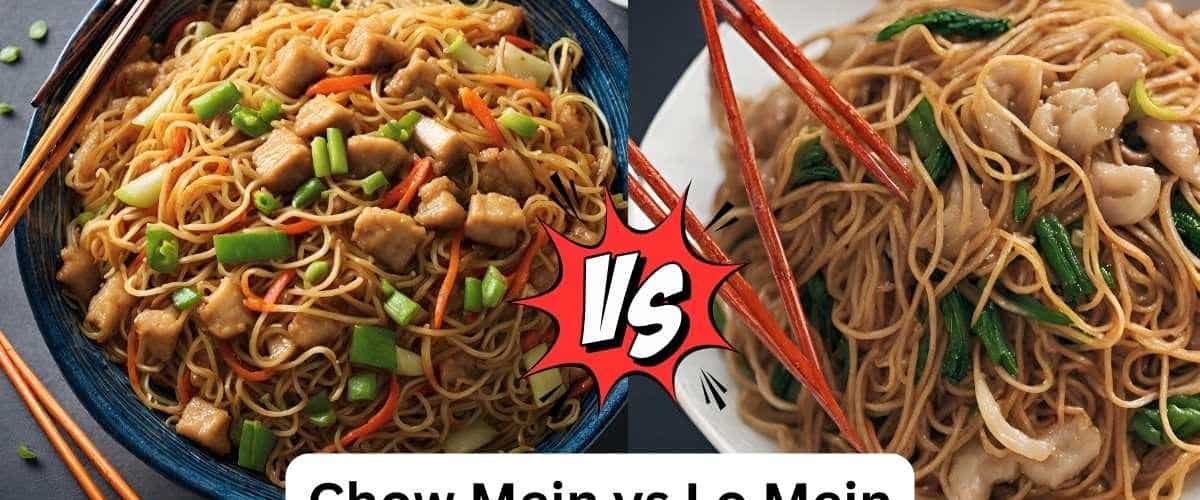Key Difference Between Chow Mein and Lo Mein
The main difference between Chow Mein and Lo Mein lies in the texture of the noodles and the cooking method:
- Chow Mein: The noodles are parboiled and then stir-fried until they’re crispy. The dish is drier and has a crunchy texture.
- Lo Mein: The noodles are fully cooked until soft and then tossed with a sauce, resulting in a softer, moister dish with a focus on the smooth texture of the noodles.

The Tale of Two Noodles
Once upon a time in the vast lands of China, two noodle dishes were born—Chow Mein and Lo Mein. They grew up in the same cultural household but took different paths in life. Let’s meet the contenders.
Chow Mein: The Crispy Connoisseur
Hailing from the northern parts of China, Chow Mein, which means ‘stir-fried noodles,’ is known for its signature crispiness. These noodles are parboiled and then stir-fried until they reach a golden-brown hue. They’re often mixed with a choice of meat—be it chicken, beef, shrimp, or pork—and a colorful medley of vegetables like cabbage, carrots, and bean sprouts. The result? A dish that’s as crunchy as it is delightful.
Lo Mein: The Silky Smooth Operator
Lo Mein, on the other hand, is the silky counterpart to Chow Mein. Its name translates to ‘tossed noodles,’ and that’s exactly how they’re prepared. The noodles are fully cooked until they’re perfectly pliable and then tossed with a sauce that’s rich with flavors like garlic, oyster sauce, and soy sauce. They’re joined by similar meats and veggies, but the outcome is a softer, more slurp-worthy experience.
Breaking Down the Battle
While both dishes start with similar ingredients—wheat flour noodles and a mix of proteins and vegetables—the key differences lie in the preparation and texture.
Texture Talk: Chow Mein noodles are stir-fried twice—once to cook and then again to crisp up. In contrast, Lo Mein noodles are boiled and then just tossed in the sauce, remaining soft and smooth.
Sauce Saga: Chow Mein is drier, usually cooked with less sauce to maintain its crunchiness. Lo Mein is saucier, often drenched in a savory sauce that clings to the noodles lovingly.
Veggie Variety: Both dishes are versatile; however, Chow Mein might lean towards crispier veggies to complement its texture, while Lo Mein can handle softer vegetables that meld with its sauciness.
The Taste Test
When it comes to flavor, Chow Mein offers a more varied texture with each bite, often accompanied by a smokier flavor due to the high-heat stir-frying process. Lo Mein is all about that smooth, saucy embrace that coats your palate with every noodle slurp.
The Nutritional Knockout
Health-conscious foodies might wonder which dish wins in the nutritional ring. The answer isn’t straightforward. Both can be customized to be as healthy or indulgent as you wish. Opting for more veggies and lean proteins can make either dish a balanced meal. But if you’re watching your calorie intake, the double frying of Chow Mein might put it a tad higher on the calorie chart.
The Versatility Victory
Both Chow Mein and Lo Mein are incredibly versatile. They’re like the chameleons of the food world, adapting to whatever ingredients you have on hand. Got leftover veggies? Throw them in. Want to make it vegetarian? Skip the meat. The possibilities are endless.
The Cultural Cuisine Connection
While both dishes have their roots in Chinese cuisine, they’ve traveled the world and picked up local flavors. In the West, you might find variations that aren’t traditional but are equally delicious, proving that good food knows no borders.
The Final Forkful
So, who wins this noodle showdown? It’s a tie! The choice between Chow Mein and Lo Mein boils down to personal preference. Do you crave a crispy bite, or are you in the mood for some saucy slurping? Whichever you choose, you’re in for a treat.
The DIY Dare
Why not take the noodle challenge into your own kitchen? Cooking Chow Mein or Lo Mein at home allows you to control the ingredients, the sauce, and the level of crispiness or sauciness. It’s a culinary adventure that’s as fun as it is tasty.
Chow Mein Recipe
Ingredients:
- 200g chow mein noodles
- 2 tablespoons vegetable oil
- 1 chicken breast, thinly sliced (optional)
- 1 cup of mixed vegetables (such as sliced bell peppers, cabbage, and carrots)
- 2 green onions, chopped
- 2 tablespoons soy sauce
- 1 tablespoon oyster sauce
- 1 teaspoon sesame oil
- 1 teaspoon sugar
- Salt and pepper to taste
Instructions:
- Boil the chow mein noodles according to the package instructions, usually for about 2-3 minutes, then drain and set aside.
- Heat one tablespoon of vegetable oil in a large wok or frying pan over high heat. Add the chicken slices and stir-fry until cooked through. Remove the chicken and set aside.
- Add the remaining oil to the wok, then add the mixed vegetables and stir-fry until they are just tender.
- Add the cooked chicken back into the wok with the vegetables.
- Add the drained noodles to the wok with the chicken and vegetables.
- In a small bowl, mix the soy sauce, oyster sauce, sesame oil, and sugar.
- Pour the sauce over the noodles and stir-fry everything together for about 2 minutes, or until the noodles are heated through and have a slightly crispy texture.
- Season with salt and pepper to taste and sprinkle the chopped green onions on top before serving.
Lo Mein Recipe
Ingredients:
- 200g lo mein noodles or spaghetti
- 2 tablespoons vegetable oil
- 1 chicken breast, thinly sliced (optional)
- 1 cup of mixed vegetables (such as bok choy, mushrooms, and snow peas)
- 2 cloves garlic, minced
- 3 tablespoons soy sauce
- 2 tablespoons hoisin sauce or oyster sauce
- 1 teaspoon sesame oil
- 1 teaspoon sugar
- Salt and pepper to taste
Instructions:
- Cook the lo mein noodles according to the package instructions until soft. Drain and set aside.
- In a large wok or pan, heat the oil over medium-high heat. Add the chicken and stir-fry until browned and cooked through. Remove the chicken and set aside.
- In the same wok, add a bit more oil if necessary, and sauté the garlic until fragrant.
- Add the mixed vegetables and stir-fry until they are cooked to your liking.
- Return the chicken to the wok and add the cooked noodles on top.
- In a bowl, whisk together the soy sauce, hoisin sauce or oyster sauce, sesame oil, and sugar.
- Pour the sauce over the noodles and toss everything together until the noodles are well coated and heated through.
- Adjust seasoning with salt and pepper as needed, and serve hot.
These recipes are very adaptable. Feel free to add your preferred proteins or vegetables, and adjust the sauce ingredients according to your taste. Enjoy your homemade Chow Mein and Lo Mein!
The Takeaway
Whether you’re a Chow Mein champion or a Lo Mein lover, one thing’s for sure—noodles bring joy. They’re a staple that’s stood the test of time, and for a good reason. They’re delicious, adaptable, and they tell a story of cultural history and culinary creativity.
So, the next time you’re faced with the Chow Mein vs Lo Mein dilemma, remember: there’s no wrong choice in the delicious world of noodles. Now, grab your chopsticks and let the noodle feast begin!












Leave a Comment